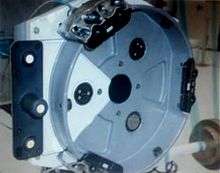European Robotic Arm
The European Robotic Arm (ERA) is a robotic arm to be attached to the Russian segment of the International Space Station. It will be the first robot arm able to work on the Russian space station segments, and will supplement the two Russian Strela cargo cranes that are already installed on the Pirs module. The ERA is designed and assembled by Dutch Space, an EADS Astrium company.
Major features and tasks
The ERA has several interesting features. Most prominent are its ability to 'walk' around the exterior of the Russian segments of the station under its own control, moving hand-over-hand between pre-fixed basepoints, and its ability to perform many tasks automatically or semi-automatically, thereby freeing its operators to do other work. Specific tasks of ERA include:
- Installation and deployment of solar arrays
- Replacement of solar arrays
- Inspection of the station
- Handling of (external) payloads
- Support of astronauts during space walks
The International Space Station already features three robotic arms, the first being the Canadarm2, but because the Russian grapple fixtures are different, that arm and Dextre can only be used on the Zarya module of the Russian segment.[1] The third arm is fixed on the Japanese Experiment Module, the Remote Manipulator System (JEM-RMS) uses a similar grapple fixture to Canadarm2. Because all Russian and European spacecraft dock automatically there is no need to manipulate spacecraft on the Russian segment so the European arm is half the length and less powerful than Canadarm2.
Developed for the European Space Agency (ESA) by a number of European space companies, with Dutch Space as prime contractor and subcontractors in 8 countries, the robot arm will be launched by a Proton rocket, along with the MLM, in 2017 (previously planned: 2015) to be put to work in space by the ISS crew. In 2010, a spare elbow joint for the arm was launched preemptively, attached to the Mini-Research Module 1 (MRM-1). The MLM will also serve as home base for ERA; originally, the arm was going to be attached to the cancelled Science Power Platform which would have had eight solar arrays.[2]
Control of ERA

Astronauts can control the robot from both inside and outside the space station. Control from inside the space station (Intra Vehicular Activity-Man Machine Interface (IVA-MMI)) uses a laptop, which shows a model of the ERA and its surroundings. Control from outside the space station (Extra Vehicular Activity-Man Machine Interface (EVA-MMI)) uses a specially-designed interface that can be used while in a spacesuit.
Arm components

- Two 'limbs': symmetrical arm sections made of carbon fibre, approximately 5 metres long
- Two identical gripper mechanisms (End Effectors ('EE')) also capable of transferring data, power or mechanical actuation to payloads
- Two wrists with three joints each
- One elbow joint
- One central control computer within the arm ('ECC')
- Four camera and lighting units ('CLU')
Project status
- 2005 - final qualification and delivery to the customer
- May 2010 - STS-132 - preemptive launch of a spare elbow joint with 2 limbs for ERA to the International Space Station
- 2017 - Launch of ERA with the Russian Multipurpose Laboratory Module on a Proton rocket[3][4]
Technical data

- Total length - 11.3 metres (37 ft)[5]
- Launch Mass - 630 kilograms (1,390 lb)[5]
- Maximum payload mass - 8,000 kilograms (18,000 lb)[5]
- Maximum Tip Speed - 0.1 metres per second (0.33 ft/s)
- Tip Positioning accuracy - 5 millimetres (0.20 in)
See also
- Canadarm, which was used on the Space Shuttle
- Mobile Servicing System (MSS), also known by its primary component the Canadarm2, used on the ISS
- The Remote Manipulator System, used on the ISS module Kibo
- Dextre, also known as the Special Purpose Dexterous Manipulator (SPDM), used on the ISS
- Strela, a crane used on the ISS to perform similar tasks as the Mobile Servicing System
References
- ↑ http://www.nasa.gov/pdf/538352main_sts134_presskit_508.pdf
- ↑ http://www.russianspaceweb.com/iss_nep.html
- ↑ "New money for the old "Science"" (in Russian). Gazeta.ru. 2011-10-19. Retrieved 1 February 2012.
- ↑ http://www.esa.int/About_Us/ESA_Publications/ESA_Publications_Bulletin/ESA_Bulletin_160_Nov_2014 p. 61.
- 1 2 3 H.J. Cruijssen, M. Ellenbroek, M. Henderson, H. Petersen, P. Verzijden and M. Visser (May 2014). "42nd Aerospace Mechanism Symposium: The European Robotic Arm: A High-Performance Mechanism Finally on its way to Space" (PDF). NASA. pp. 319 to 333. Retrieved 22 October 2014.
External links
| Wikimedia Commons has media related to European Robotic Arm. |
- European Robotic Arm - ESA's description and specifications of the arm from July 2004
- ERA - Description, with photos, from Dutch Space

